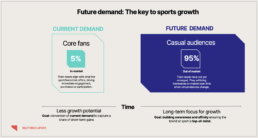As a Research & Strategy Director deeply involved in the sports industry, I’ve observed a focus on short-term wins – be it digital engagement, cost-per-acquisition, or immediate ticket sales.
Conversations constantly buzz about tapping into first-party data and new tech – which mainly focus on getting even more return from the fans. While these strategies yield quick results, they risk neglecting the long-term growth essential for the sustainability of any sports organisation.
Balancing short-term wins with long-term growth
So, how can we keep those shorter-term wins while building up future demand for sport?
It boils down to a basic marketing principle: sports organisations have two jobs of equal importance. First, the conversion of existing demand to capture a share of short-term gains. Second, brand-building among future fans so that when they’re ready to engage, they choose your sport over the competition.
Why future demand matters
According to the 95:5 Principle, only 5% of your potential market is ready to engage or make a purchase at any given time. Yet this is where many sports organisations focus their efforts – aiming for the quicker wins.
Meanwhile, the remaining 95% represents a vast reservoir of future demand that’s often overlooked. Industries like entertainment actively build future demand by staying top of mind with potential audiences.
Instead of focusing solely on the immediate 5%, sports organisations should invest in strategies that keep them top of mind among the 95% who will engage later on.

This doesn’t mean neglecting current engagement; rather, it complements it. By building brand awareness and fostering emotional loyalty now, you enhance the efficiency of future conversions, making your marketing spend more effective over time.
To achieve sustainable growth, it’s crucial to balance short-term activation with long-term brand building. This involves fostering emotional connections, maintaining mental availability, and expanding audience reach. Let’s explore how each of these elements contributes to building future demand.
Emotional connections that drive long-term loyalty
Are you merely engaging your fans transactionally, or are you building lasting emotional connections?
Creativity matters here: storytelling, behind-the-scenes content, etc. are pivotal in driving fan loyalty. Fans who develop an emotional connection are significantly more likely to stay engaged in the long run.
This investment aligns directly with building future demand. When fans feel a deeper connection to a sport or an athlete, they’re more likely to remain steadfast, so it’s important to prioritise emotional connections over purely transactional interactions.
Key takeaway: prioritise creativity and build emotional connections through engaging storytelling to foster long-term loyalty and keep your sport relevant.
Staying top of mind matters
Studies show that brands should maintain visibility across diverse contexts, such as live events, trending conversations, popular culture, free-to-air TV. Maintaining mental availability means being present at the right time, wherever your audience is, to create vital memory structures that influence future decisions.
However, moving content behind paywalls can significantly reduce mental availability. While paywalls offer immediate commercial benefits, they can diminish your sport’s presence in fans’ daily lives, affecting long-term engagement and allegiance.
Key takeaway: to build future demand, keep your sport visible and accessible across as many platforms as resources allow. Paywalls might offer immediate gains but may diminish long-term fan engagement and loyalty.
Market penetration: go beyond hardcore fans
Concentrating solely on heavy viewers restricts growth potential. Market penetration involves reaching a broader audience, including casual viewers who watch only high-profile events. The real opportunity lies in engaging these light viewers and converting them into more consistent fans.
Yet many sports properties cater primarily to hardcore fans, doing little to engage a wider audience. To unlock true growth potential, they must shift their focus to include casual viewers and non-fans. Broadening your reach and making your sport accessible to new audiences creates opportunities for sustainable growth that extend far beyond your existing fan base.
Key takeaway: expand beyond hardcore fans to engage casual audiences to broaden reach and drive sustainable growth.
Measuring what matters
Are you focusing on metrics that truly drive long-term success?
Most sports properties concentrate on short-term metrics and overlook what genuinely matters for sustained growth. Thoughtful engagement is about more than collecting likes or adding names to a CRM system – it’s about creating meaningful connections and familiarity that lead to lasting loyalty.
Rather than fixating on immediate performance indicators, evaluate how effectively you’re building brand equity. Are you memorable? Do you resonate emotionally with your audience? Do fans think of you when deciding what to watch or how to spend their leisure time? The answers to these sorts of question are what will drive future demand.
Key takeaway: focus on measuring long-term brand equity by evaluating brand awareness, emotional engagement and fan recall. Meaningful connections with fans drive future demand.
Conclusion: the case for future demand
While the short-term commercial imperative to deliver revenue is understandable, long-term thinking is critical for the success of any sport. The industry’s focus on immediate gains can make meaningful growth difficult to achieve – and could undermine the future of sports.
By adopting a balanced approach – focusing on emotional connections, expanding mental availability and prioritising broad audience engagement – sports organisations can foster future demand. Such strategies will convert today’s active fans more effectively as well as ensuring a much larger audience ready and eager to engage when they come into the market for sport and entertainment activities.
In a crowded sport and entertainment landscape, building future demand is not optional – it’s essential. Investing in the future will enable your sport to survive and to thrive.
To find out how we can help get in touch with Chris Argyle-Robinson.
Sign up to our Redtorch Lights newsletter full of news, reports and opinions relevant to anyone working in sport.
Chris Argyle-Robinson
Digital savvy. Always inquisitive. Sport loving and father of two young and very energetic girls.
My most memorable sporting moment is …
Spectating: Zenit St Petersburg v Liverpool with fellow director / friend Alex Ross.
Participating: Marathon in 3hr 40mins.
I am happiest when …
With family on the beach or in the mountains.
The sports person that best represents me is …
Geraint Thomas.
The three things at the top of my bucket list are …
1. Heli skiing with family and friends
2. Visit South Georgia and the South Sandwich Islands
3. Climb Everest / Surf Chicama
A quote I try to live my life by is …
“It is not the strongest of the species that survives, nor the most intelligent that survives. It is the one that is most adaptable to change.”





